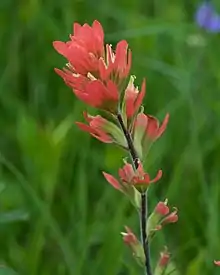Castilleja coccinea
Castilleja coccinea, commonly known as scarlet Indian paintbrush or scarlet painted-cup, is a flowering plant in the family Orobanchaceae. It is usually found in moist meadows, prairies, and barrens from Maine to Minnesota, and south to Florida and Louisiana.[1]
| Castilleja coccinea | |
|---|---|
 | |
| Castilleja coccinea | |
| Scientific classification | |
| Kingdom: | Plantae |
| Clade: | Tracheophytes |
| Clade: | Angiosperms |
| Clade: | Eudicots |
| Clade: | Asterids |
| Order: | Lamiales |
| Family: | Orobanchaceae |
| Genus: | Castilleja |
| Species: | C. coccinea |
| Binomial name | |
| Castilleja coccinea | |
Description
It is an upright, hairy, 1-to-7-decimeter (3.9 to 27.6 in) tall hemiparasitic plant. The stem is usually unbranched and rises from a basal rosette.[2][3] The basal leaves are oblong and mostly entire, while the alternate stem leaves are deeply and irregularly lobed. The common names for this plant reflect the showy red calyx, inside of which is the actual greenish-yellow corolla ("flower").
Castilleja coccinea can be distinguished from other Castilleja of the southeastern US because it has a 2-to-3.5-millimeter long, thin yellowish or orangish lip on the corolla, the inflorescence bracts are deeply lobed, and the basal rosettes of leaves are usually well-developed.[4]
Reproduction

C.coccinea have color polymorphism, which means that they can be yellow or scarlet in color, and this depends on the availability of pollinators such as bees. When pollinators are present, the scarlet C. coccinea tend to have a higher reproductive output, as they have higher seed and fruit set. On the other hand, the yellow C.coccinea would have a higher reproductive output when pollinators are scarce.[5]
Natural history
Though it can survive on its own, studies indicate a forty-fold growth increase when its roots parasitize those of another plant for nutrients.[6] It is primarily pollinated by ruby-throated hummingbirds who can transfer the pollen long distances between typically small and scattered populations of this plant.
References
- Horn, Dennis (2005). Dennis Horn; Tavia Cathcart; et al. (eds.). Wildflowers of Tennessee, the Ohio Valley, and the Southern Appalachians : the official field guide of the Tennessee Native Plant Society. [Edmonton]: Lone Pine Pub. p. 282. ISBN 9781551054285.
- Radford, Albert E.; Ahles, Harry E.; Bell, C. Ritchie (1983). Manual of the vascular flora of the Carolinas (9. printing. ed.). Chapel Hill, NC: Univ. of North Carolina Press. p. 961. ISBN 0807810878.
- Porcher, Richard D.; Rayner, Douglas A. (2001). A guide to the wildflowers of South Carolina. Columbia, S.C.: University of South Carolina Press. p. 116. ISBN 1570034389.
- Weakley, Alan (2011). Flora of the Southern and Mid-Atlantic States (Working draft ed.). Chapel Hill, NC (University of North Carolina): Not yet published. p. 843.
- Kim, E. S., D. N. Zaya, J. B. Fant, and M. V. Ashley. "Reproductive trade-offs maintain bract color polymorphism in Scarlet Indian paintbrush (Castilleja coccinea)". PLoS ONE 14: e0209176. doi:10.1371.
- Spira, Timothy P. Wildflowers & plant communities of the southern Appalachian Mountains & Piedmont: a naturalist's guide to the Carolinas, Virginia, Tennessee, & Georgia. Chapel Hill: University of North Carolina Press. p. 345. ISBN 9780807871720.
External links
 Media related to Castilleja coccinea at Wikimedia Commons
Media related to Castilleja coccinea at Wikimedia Commons